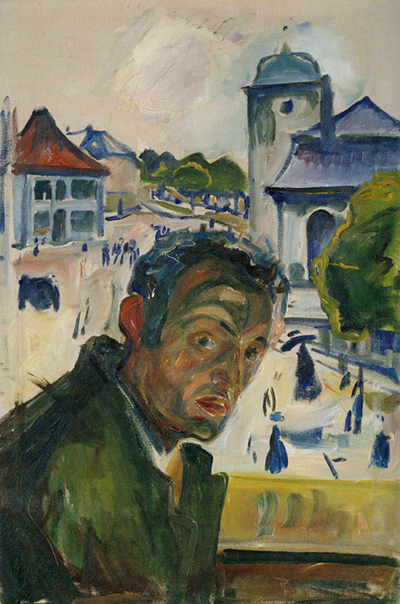Munch created his Self Portrait in Bergen in 1916. The work is considered to be one of the artist's later works and follows a theme of producing images of himself, using various media, throughout his career.
Munch described how "I do not paint what I see, rather what I saw". This suggests that his work was aimed to be Expressionism rather than representing the reality of the subject. The 1916 Self Portrait is an oil on canvas work. Self Portrait in Bergen shows the subject sitting sideways within the scene while turning his head to look towards the artist. The location appears to be a raised platform or balcony overlooking a busy street scene below. The facial expression of the subject appears to be rather sad and the shoulders and body are slumped forward giving an impression that the artist/subject was not happy at the time of painting. The human shapes of the street scene depicted in the background of the portrait are not clearly defined, although the impression is of a bustling population unaware of the artists presence above them.
The 1916 Self Portrait in Bergen differs from many of the artist's other earlier works, both self portraits and the commissioned portraits Munch painted to earn his living, in that it depicts a realistic background featuring what appear to be trees, a church and other large buildings. Many of Munch's portraits and self portraits have only an abstract background consisting of broad brushstrokes and contrasting colours which highlight the main subject of the painting without distracting attention away from it. It maybe that Munch's interest in photography was having an impact upon his painting, leading to him providing a more realistic backdrop to his work.
As with the majority of the artist's work, this 1916 self portrait is to be found in the Munch Museum in Oslo, Norway. The museum houses over 28,000 items of artwork produced by Munch during his lifetime. The collection was presented to the nation upon Munch's death in 1944. when he was 80 years old. The artist saved almost every item he produced. Consequently, there are preparation sketches and drawings which were the precursor to the artist's paintings and lithographs. There are also technical drawings showing the preparation for the photographic art which is also a large part of the collection. The collection will move to a new location on the Oslo waterfront early in 2021.




